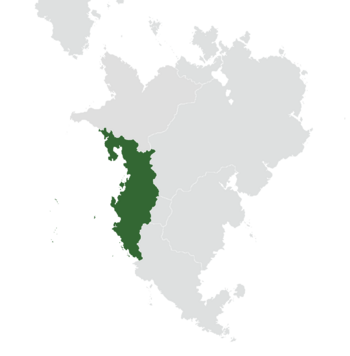User:Gibia/sandbox2
Sacred Kayahallpan State | |
|---|---|
|
Flag | |
| Motto: Sakwi, Mama Llaqta, Kururay "Sakbe, The Nation, Progress" | |
| Anthem: Wari Llaqta Takin "National Anthem of Wari" | |
 Location of Kayahallpa in Oxidentale | |
| Capital | Tupawasi |
| Largest | Tupaq Churan City |
| Official language | Kaya Simi |
| Locally recognized languages | Warin Richi Aruk Apa Itukali various others |
| Ethnic groups | |
| Religion | Sakbe (99.8%) Other (0.2%) |
| Demonym(s) | Kayahallpan, Kayan, Warian |
| Government | Theocratic technocratic republic |
• Kamasqa | Qaparipuyll Wuluk |
• Great State Council | 32 members |
• Willaq Umu | X |
• Suyupa Rantin | X |
| Legislature | Chosen Court |
| Formation | |
• Chincha civilization | 4000 BCE |
• Wari federation | 480 CE |
• Warisuyu | 1045 |
• New Kayamucha | 1434 |
• Restoration of New Kayamucha | 1818 |
• Constitutional Reformation | 1927 |
• Monarchy abolished | 1956 |
• Kayahallpan Revolution | 1960 |
| Area | |
• | 1,414,464 km2 (546,128 sq mi) |
• Water (%) | 1.2 |
| Population | |
• 2020 census | 64,226,754 |
• Density | 45.5/km2 (117.8/sq mi) |
| GDP (nominal) | 2020 estimate |
• Total | $919.8 billion |
• Per capita | $14,321 |
| Gini (2020) | 41.6 medium |
| HDI (2021) | high |
| Currency | Qullqi |
| Date format | dd/mm/yyyy |
| Driving side | right |
| Calling code | 36 |
| ISO 3166 code | KY |
| Internet TLD | .ky |
Kayahallpa (Kaya Simi: Kayahallpa [kæjæˈhæʎpæ]), and officially the Sacred Kayahallpan State or Wari, is a country in western Oxidentale. It borders the Mutul to the north, Sante Reze and Yadokawona to the east, Aztapamatlan to the south-east and the Makrian Ocean to the west. The country has three constitutionally defined capital cities: the "greater capital" of Tupawasi in central Kayahallpa, and the "lesser capitals" of Tupaq Churan City in the north and Huirquihui in the south. It has a population of near 65 million and its largest city is Tupaq Churan City.
Kayahallpa has been home to many cultures stretching back at least 6000 years including the coastal Chincha civilization, the old Nahuas, the highland Warisuyu Empire, and the current Kayan society. While its history has been shaped by a number of global powers, Kayahallpan territory has almost always been ruled by Oxidentalese states.
The modern state of Kayahallpa traces its origin to the ancient Kayans, who migrated from Norumbia due to the 14th century socio-economic collapse of the Kayamuca Empire and waged war against the native Warisuyu Empire. After the Warisuyu collapsed with the 1376 Fall of Tupawasi, the competing Kayan clans fought for supremacy with the Wiraqucha Clan ultimately winning and establishing the New Kayamucha in 1434 CE. The New Kayamucha lasted until the advent of the 17th century, when the rise of the Mutuleses colonial empire brought with it incursions into the Kayahallpan coast. A series of wars brought Kayan power into a steady decline, which never recovered. Under the influence of Mutunese-educated rulers, most of Kayahallpa was converted to Sakbeism during the Kayan religious revolution with heavy influences from the traditional faith. Beginning in 1791, the post-Kayamuchan ruler Tupaq Churan launched a series of military campaigns and fought against the Mutulese and their subjects, officially restoring the New Kayamucha. The inability of his descendants to reconcile internal frictions and avoid costly wars led to the 1924-1927 Kayahallpan Spring, a period of rapid internal changes which led to democratic reforms. The Kayan Workers' Party dominated elections and led the country into a profound wave of industrialization and liberalization, but also provoked the ire of traditionalist and nationalist factions. In the late 1950s, KWP leader Kaman Yashakphi began to centralize power under a one-party ordosocialist system and expelled the last monarch, Tupaq Yupanki III. Yashakphi was overthrown in the 1960 Kayahallpan Revolution, which established a 'revolutionary and divine republic' under Kamasqa (Divine Priest) Pitiy Achtil, followed by a decade of unrest as the communist RAA launched a guerilla campaign against the Kamasqic regime.
The Government of Kayahallpa is a Sakbeist theocracy, spiritually and temporally led by the Kamasqa, with notable technocratic elements and weaker democratic ones. The current Kamasqa since 2005 is Qaparipuyll Wuluk, who exerts power with the Great State Council. There is a legislature, which has for all meaningful purposes remained subservient to the ruling forces since the early revolution. It is a developing country with medium-high human development levels and a moderately complex economy largely dominated by the copper industry. Much of Kayahallpa is arid, with large plateaus and mountain ranges covering most of its land area. While the country has a long coastline, much of it is sparsely populated desert, occasionally broken up by heavily populated river basins and mist oases. Large parts of the country are irrigated for agricultural production. At 1.412 million square kilometers in area, it is the fourth largest country in Oxidentale. Sante Reze and the Mutul are Kayahallpa's largest trade partners and have been its closest allies after the Kayahallpan Revolution. Kayahallpa is a member of the Common Congress and the Forum of Nations, among other international organizations.
The people of Kayahallpa come from a variety of backgrounds, mainly indigenous to Oxidentale as well as significant numbers of Norumbian and Malaioan descent. Kaya Simi is the national language, and co-official with a local language in most regions. Increases in agricultural efficiency and the abolition of settlement restrictions facilitated rapid urbanization in the mid to late 20th century, which transformed the political, social, cultural, and economic landscape of the country.
Etymology
The oldest known geographical term used for the entire area of and around the Antis mountains of western Oxidentale is Wari, from an ancient highland city of the same name, attested in records around 480 CE. Wari has continued in usage as a term for the general region in the modern day, and was introduced as the co-official name of the country during the Constitutional era. Between 1434 and 1926, the name of the state was the New Kayamucha, derived from the historical maritime Norumbian-Oxidentalese Kayamuca Empire. The name Kayahallpa was not coined before the 18th century, when it was introduced as a nationalistic rallying cry against the country's Mutulese rulers, combining the ancient empire's name with the Kaya Simi word for land, hallpa. There are two hypotheses for the origin of the name kaya itself, either being a loaned term appropriated during the age of the Kayamuca, or stemming directly from Proto-Kayaic.
History
Ancient Era
Pre-Modern Era
Mutulese Era
Independence Era
Government and politics
The Politics of Kayahallpa is regulated by the post-revolutionary 1960 Kayahallpan Constitution, which established a theocracy with elements of technocracy and a limited democracy. Ultimate political authority is constitutionally defined as originating from the Gods of the Sakbeist religion, and the official Kayan Priesthood is charged with approving the Kamasqa, the nation's leader, and members to the Great State Council, the highest state organ. The Kayan Priesthood is legally based from the Sakbeist-only and holy city of Qusqu; most of the government is based in the greater capital, Tupawasi, with smaller representation in Tupaq Churan City and Huirquihui. Kayahallpa operates as a partially devolved state where local administrative units have some political authority to enact their own legislation, the country remaining de jure unitary.
The government's central figure is the Kamasqa, also known as the Divine Priest or Supreme Leader, chosen from the uppermost ladder of Kayahallpan Sakbeist leaders. The Kamasqa is the country's head of state and leads the polytheistic Sakbeist faith in Kayahallpa. The Kamasqa serves for life once elected by the upper Kayan Priesthood and wields unquestionable authority across all spheres of Kayahallpan politics, making judgements on all matters of government in the Sacred State. Qaparipuyll Wuluk succeeded Ruqa Wiraqucha as Kamasqa in 2005. Ruqa Wiraqucha in turn succeeded Pitiy Achtil, the first Kamasqa, in 1986.
The most central government organs below the Kamasqa are the technocratic Great State Council, the religious Kayan Priesthood, and the democratically elected Chosen Court. The Great State Council is composed of engineers and other technical experts who are given a constitutional mandate to deliberate on various aspects of day-to-day government, most importantly to coordinate economic policy, regulate development, plan civil infrastructure, iron out labor policy, and organize regulations for Kayahallpan universities. Decisions made by the council can be delayed, but not overturned, by the Chosen Court; the Kamasqa and the priesthood can veto any of its decisions. The appointment of members to the council is controlled by the Kayan Priesthood, which is mainly tasked with maintaining the religious-ideological system of the Sacred State, ensuring it stays adhered to its Sakbeist foundations. The chairman of the Priesthood is the Willaq Umu. The Chosen Court is the national legislature of Kayahallpa and of its representatives, 75% are democratically elected by the people, with the remaining 25% appointed by the Priesthood. The Suyupa Rantin functions as President of the Court. Factions of the legislature are typically positioned on a traditionalist-reformist spectrum; there is heavy systematic bias against reformist politicians, with biased media reports and state-organized political violence being common, and reports have been made of extortion, psychological torture, house arrests, and unwarranted imprisonment against people critical of the regime.
Law
The Kayahallpan legal system is based on a modern Kayahallpan interpretation of Sakbeist scripture, largely inspired by the works of authors in early modern Kayahallpa, the Mutul, and the Mutulese Ochran, and the writings of modern Kamasqas. The education of judges is based on a combination of religious dogma for ethical matters and secular civil law for technical ones. The death penalty is legal and may be used for a variety of crimes including murder, treason, and blasphemy; the number of executed people or even death sentences is considered a state secret, but is likely to be hundreds of persons a year. It is not known what percentage of death sentences is actually carried out, as some of them are remitted to life imprisonment or forced labor.
Demographics
The population of Kayahallpa was counted at 64,226,754 in the 2020 census by the Kayahallpan Statistics Agency, an increase from 56,922,691 in the 2010 census giving an annual population growth rate of 1.12% in that decade. Roughly 70.6% of them live in urban areas, up from 68.4% in 2010.
Religion
It is estimated that 99.8% of the Kayan population is Sakbeist, mostly followers of the Yuyaqpi school, a descendant of colonial-era movements that held Chak-Wiraqucha as the nation's patron god. The polytheistic White Path (Sakbe) faith is the only permitted religion in the country and completely dominates every stage of daily life, as all citizens are officially registered into the religion at birth. Apostasy, conversion to another religion, attempting to convert a citizen to any other faith or bringing forbidden religious material into the country is illegal and may result in imprisonment, deportation (for foreign citizens) or, in especially egregious cases, capital punishment. While foreigners are generally allowed to practice their beliefs in private if they do not otherwise violate any laws, they still face intense societal opposition; no churches, mosques or any other non-Sakbeist religious institutions exist.
